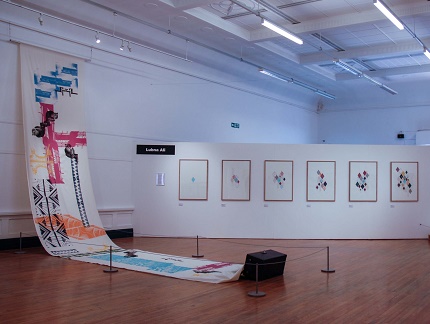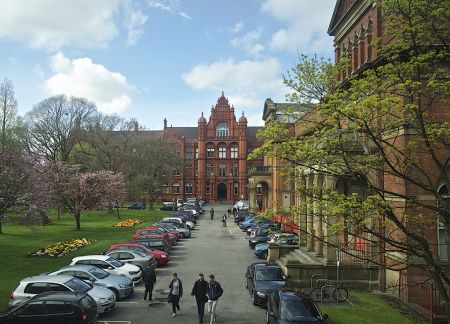
Graduates' printmaking work displayed at gallery
Wednesday 13 June 2018
WORK by University of Salford graduates is on display at Salford Museum And Art Gallery as part of an exhibition celebrating contemporary printmaking.
The PRINT UnLtd exhibition, running until October, showcases new work by Manchester and Salford based artists.
To introduce printmaking to new audiences, alongside the exhibition there will be a range workshops and talks, including a programme of family friendly activities over the summer holidays.
Sarah Spence, Director of Libraries and Culture for Salford Community Leisure, said: "We're delighted to welcome the Print UnLtd exhibition to Salford Museum and Art Gallery in conjunction with the University of Salford and Hot Bed Press.
"We're always keen to present new artworks by North West artists and offer engaging experiences to visitors to the museum. We hope that this exhibition inspires a next generation of artists."

Led by Salford Museum and Art Gallery, in partnership with the University of Salford Art Collection and Hot Bed Press (Salford), PRINT UnLtd showcases work by artists Lubna Ali, Claudia Alonso, Joey Collins and Gwilym Hughes. As resident artists at Hot Bed Press and University of Salford Art Collection Graduate Scholars Ali and Alonso were invited to submitted work for the exhibition. Collins and Hughes were selected following an open call.
The University of Salford Art Collection Graduate Scholarship Programme supports artists in the crucial first year after graduation. It grants University of Salford Arts and Media graduates, time and resources to experiment and take risks with their creative practice within a supportive framework.
All works in the exhibition are for sale and as part of the commission each artist will gift one of the artworks to the University of Salford Art Collection for inclusion in the University’s permanent collection.
The artists have worked over the past three months to create bodies of work for PRINT UnLtd and each has responded to the commissioning brief in their own unique way.
My Tiles
Ali’s MyTiles has its origins in Islamic geometric pattern. All her work has been painstakingly drawn by hand, then exposed directly on the screens, rather than being scanned or edited digitally.
Prints are often, but not always, editioned. The accepted rule is to limit an edition to a set number of prints and usually each print is the same as the rest or as near to as physically possible, and has the same value.
In My Tiles, Ali plays with this process. Each print in the series of 50 is unique. As the edition number increases, another pattern and colour is added; the image builds and becomes more complex as the edition grows. Therefore, Ali has invented her own numbering system. Within the overall edition of 50 there are six sub-editions, each indicating where a new colour has been added.
Ali subverts the editioning process further by placing a different value on each sub-edition; the more colours the more expensive the prints. The first in the edition is the cheapest, the last is the most expensive as it has had more work and is more complex.
Infinite
Alonso has created a unique site-specific sculptural work, Infinite,which is made from a large-scale screen print on canvas. She photographed various architectural details inside and outside Salford Museum and Art Gallery and printed some of these images on to the large piece of fabric, which is hung from the ceiling and starts (or ends) in a suitcase.
Alonso highlights and questions the norms of presenting prints on the gallery wall and is interested in what she describes as ‘the seemingly unlimited possibilities of how it is presented to the audience and how much of the print can be seen at any one time’.
Try me
As a starting point for his body of work Try Me, Collins collected discarded drawings from art supplies shops in Manchester. These drawings are made specifically to 'try out' the pens and pencils sold in the shop.
In itself, he feels that each of these drawings is its own collaboration; the strips of paper are layered with combined words,squiggles, cartoons, and abstract marks. Collins rescues and recycles these found drawings, which he scans,enlarges, edits, separates and exposes onto silk screens and screen-printed.
He then works repeatedly into these prints using collage and drawing. Finally, hecuts them into strips, to mirror the original source material, and rearranges the strips into a new piece of work.
Although some marks may repeat and be seen in several works, no image is wholly the same.Through this process, he has formed an original body of work that he describes as ‘the ultimate open edition’. Each work is titled from words and/or images pulled from the original ‘try me’strips.
Salford Faces
Salford Faces continues Hughes’ ongoing work with anonymous faces, lost voices and unsung lives that he finds in archives. He gives new lives to people who may not have known they were ‘having their picture taken’, and may never have seen the resulting photographs, which are now found in the Salford Local History Library, based in Salford Museum and Art Gallery.
Using slow, intensive, hand drawing techniques Hughes creates a series of small relief etchings from the found photographs. Considerable time is devoted to each face. A select few have been further manipulated - blown up to create monumentally large, multi-layered digital CMYK prints. These are presented as lightboxes adding a disarming 3-D quality to an essentially intimate hand drawn image.
Hughes creates a new dimension by marrying two different printing processes. In the 19th century, etching was a cutting edge process that was used commercially to create affordable reproductions of paintings. It is now almost purely an artist’s medium.
In the 21st century, large-scale digital printing is primarily used for commercial display. By layering these images and techniques, Hughes aims to reflect the complexity of human character. Hughes, who has exhibited widely across the North West as well as in London and Japan, studied fine art at Loughborough College of Art and is the only artist in the exhibition not to have graduated from the University of Salford.
PRINT UnLtd is an exhibition by Salford Museum and Art Gallery and Salford Community Leisure in partnership with University of Salford Art Collection and Hot Bed Press. Funded by Arts Council England: Grants for the Arts.
Main image courtesy of the artists: Lubna Ali, Claudia Alonso, Joey Collins, Gwilym Hughes.





